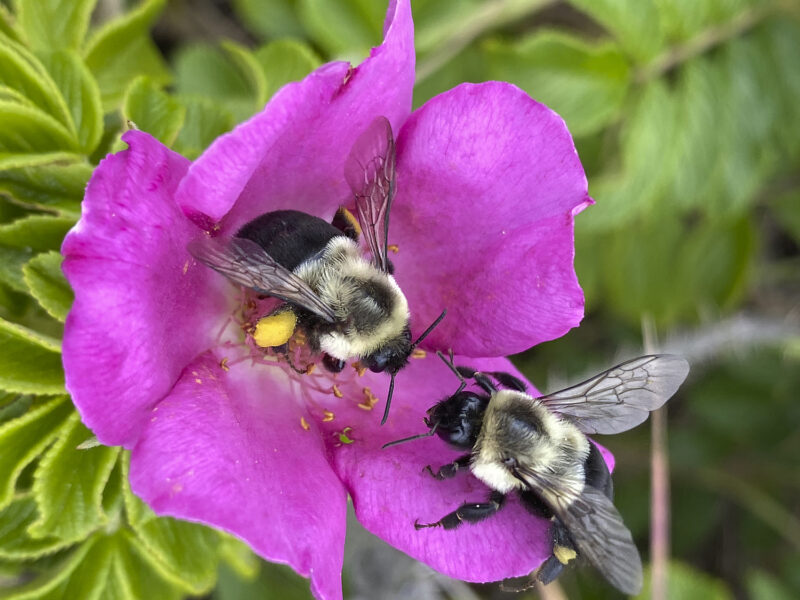

For the past two decades, scientists and beekeepers have been sounding the alarm — honeybee populations are declining, due in large part to the broad use of dangerous pesticides, especially neonics, as well as herbicides like Roundup. In addition to the outright poisoning those chemicals cause, the weakened hives they leave behind are vulnerable to infestations of parasites like varroa mites, which a healthy hive could usually fend off.
Now some of those same scholars are backpedaling a bit, with a recent article from the Xerces Society for Invertebrate Conservation noting that “Honeybees are not endangered or at risk of extinction. In addition to persisting in the wild in those regions where they are native with no significant indication of decline, there are millions of managed hives throughout the world, both within and beyond their native range. Globally, the number of hives is stable or increasing year over year.”
But then we have this: According to a study by the University of Maryland and Auburn University, 48 percent of honeybee hives in the United States were lost from 2022 to 2023, the second highest death rate ever recorded.
So what’s really going on?
A few things. First, as the Xerces article notes, honeybees are not native to North America. They were brought here from Europe in the 1620s by colonists who valued them for the honey and wax they produced. So technically, they are an invasive species, but have continued to be highly valued, both for what they produce and for their worth as pollinators. Many U.S. crops, including almonds, strawberries and squash, are dependent on honeybees for pollination. In fact, California produces 80 percent of the world’s almonds, and virtually all of those trees are pollinated by honeybees that are trucked in for the task each year.
Because of our interaction with and dependence on honeybees, we keep pretty close tabs on their overall health. And what we’ve seen has been a cause of concern, as well as an impetus for action. While a 5 percent to 10 percent colony loss over the winter was the norm for generations, in 2006, beekeepers in the United States lost more than a third of their hives, leading experts to coin the term “colony collapse disorder,” and raising alarm bells that have led to the ban of some chemicals, innovative treatments for hive parasites and a general awareness that we all need to do a better job caring for our natural environment. Beekeepers have also become better at recovering from hive losses by splitting surviving hives in the spring, so those losses aren’t as financially devastating.
Then there’s the hobbyist beekeepers. As reports of the plight of honeybees made the headlines, more people decided to try their own hands at beekeeping, driving the number of managed colonies up even higher. Between 2017 and 2022, the number of beehives in the United States rose 31 percent, to more than 3.8 million. So the overall number of hives is up, but the percentage lost from year to year is also trending up.
Another point to consider is that hobbyist beekeepers tend to have a lower success rate than professionals at keeping their hives alive over the winter. Unlike their professional peers, hobbyists often miss early signs of parasite infestation or fail to leave adequate stores of honey and/or provide enough food to get their hives through the winter.
In any case, the upside of the rising rate of hive loss is that actions taken to protect honeybees also serve to protect the nearly 4,000 species of native bees that call the United States home, like bumblebees, sweat bees and carpenter bees. The downside is that honeybees sometimes crowd out those native bees, threatening their ability to thrive.
Since each species of bee has its own proclivities and some bees are more suited to pollinating one type of plant over another, protecting all of them is important. For example, around 9 percent of the world’s flowers rely on buzz pollination, or sonication, to propagate. That’s when a bee holds tightly to a flower, moving its flight muscles rapidly, dislodging pollen from the flower’s anthers (the part that contains the pollen). Bumblebees and other solitary native bees use this technique, but honeybees cannot.
Sweat bees — small, greenish metallic-colored bees — are prolific pollinators, contributing to the survival of many wildflowers as well as being essential pollinators for crops from sunflowers to alfalfa.
So the short answer to the question of whether or not honeybees are in danger is yes and no. The longer answer is that we need to keep working to create a healthy environment, for honeybees, native bees, and ourselves.
On a personal note, both of my hives died over the winter. I’ve been dealing with having both hips replaced and was unable to do mite treatments and other tasks to keep them healthy last fall, so their death was not surprising. I decided not to replace them this year, since I’m still healing, but the universe thought otherwise. A swarm moved into one of my empty hives in early June, so I guess the bees decided I’m not taking the year off after all. And I am very happy about that!
 More Posts from Lisa Daffy
More Posts from Lisa Daffy